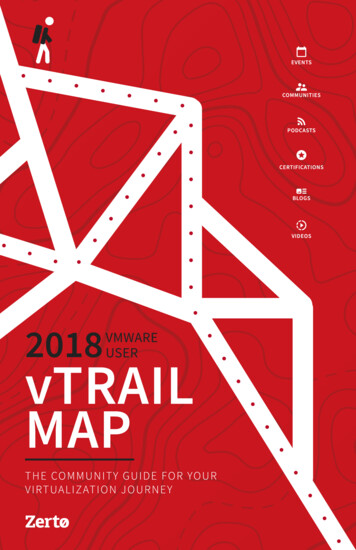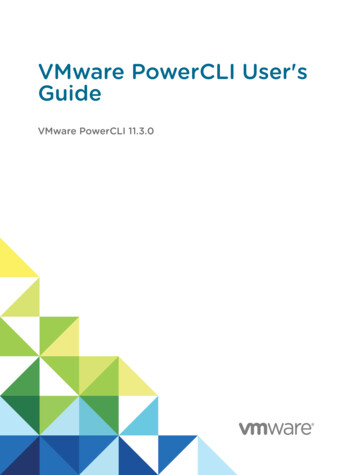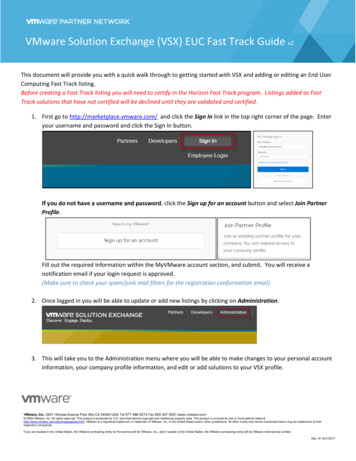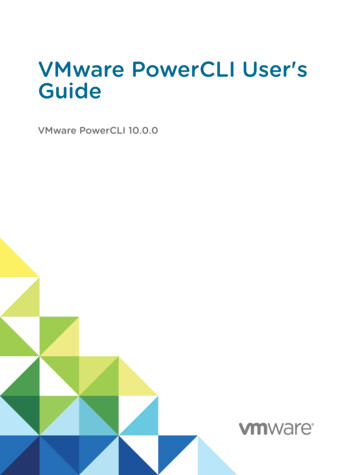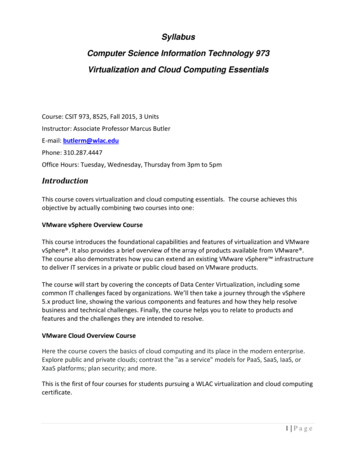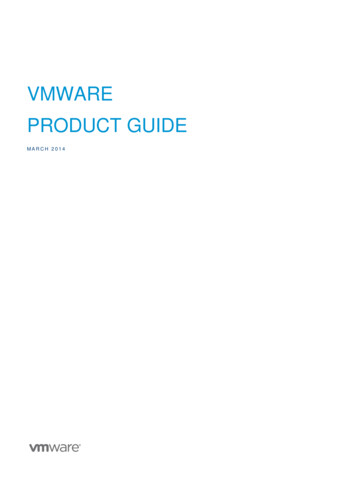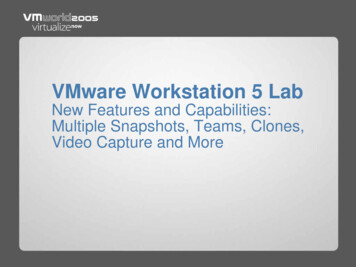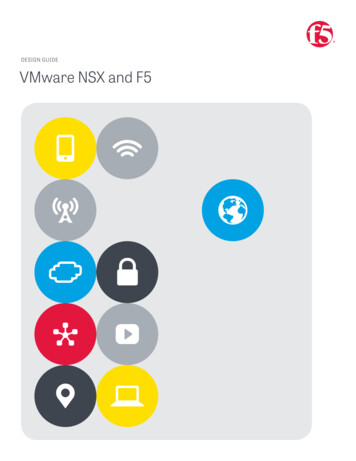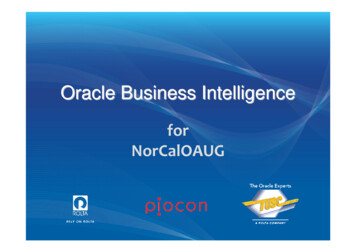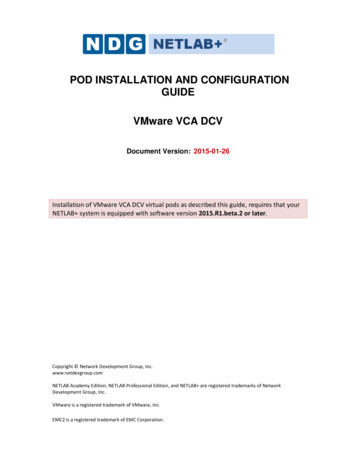
Transcription
POD INSTALLATION AND CONFIGURATIONGUIDEVMware VCA DCVDocument Version: 2015-01-26Installation of VMware VCA DCV virtual pods as described this guide, requires that yourNETLAB system is equipped with software version 2015.R1.beta.2 or later.Copyright Network Development Group, Inc.www.netdevgroup.comNETLAB Academy Edition, NETLAB Professional Edition, and NETLAB are registered trademarks of NetworkDevelopment Group, Inc.VMware is a registered trademark of VMware, Inc.EMC2 is a registered trademark of EMC Corporation.
VMware VCA DCV Pod Installation and Configuration GuideContents123456Introduction . 31.1 Introducing the VMware VCA DCV Pod . 3Planning. 42.1 Pod Creation Workflow . 42.2 Pod Resource Requirements . 52.3 ESXi Host Server Requirements. 52.4 NETLAB Requirements . 62.5 Networking Requirements . 6Obtaining Software and Licenses. 73.1 Downloading OVF Files. 73.2 Obtaining vITA Licenses. 7Master Pod Configuration. 84.1 Deploying Virtual Machine OVF/OVA Files . 84.2 Modify and Activate Virtual Machines . 104.2.1 Modify Virtual Machines. 104.2.2 Activate Licenses . 124.3 Create Snapshots for the Master Virtual Machines . 144.4 NETLAB Virtual Machine Infrastructure Setup . 144.5 NETLAB Virtual Machine Inventory Setup. 154.6 Create the Master VMware VCA DCV Pod . 164.7 Update Master Pod . 17Pod Cloning . 195.1 Linked Clones and Full Clones . 195.2 Creating User Pods on the First Host . 195.3 Copying Your Master Pod to the Second Host . 215.4 Creating User Pods on the Second Host . 22Assigning Pods to Students, Teams , or Classes. 231/26/2015Copyright Network Development Group, Inc. www.netdevgroup.comPage 2 of 23
VMware VCA DCV Pod Installation and Configuration Guide1IntroductionThis document provides detailed guidance on performing the installation andconfiguration of the VMware VCA DCV pod on the NETLAB system.1.1Introducing the VMware VCA DCV PodThe VMware VCA DCV pod is a 100% virtual pod consisting of 6 virtual machines. Linkedtogether through virtual networking, these 6 virtual machines provide the environmentfor a student or a team to perform the VMware VCA DCV labs.1/26/2015Copyright Network Development Group, Inc. www.netdevgroup.comPage 3 of 23
VMware VCA DCV Pod Installation and Configuration GuidePlanning2This guide provides specific information pertinent to delivering the VMware VCA DCVpod. The NETLAB Remote PC Guide Series provides the prerequisite guidance forsetting up your VMware infrastructure, including: An introduction to virtualization using NETLAB .Detailed setup instructions for standing up VMware vCenter and VMware ESXi.Virtual machine and virtual pod management concepts using NETLAB .This document assumes that you have set up virtual machine infrastructure inaccordance with the NETLAB Remote PC Guide Series. The planning informationbelow refers to specific sections in the Remote PC Guide when applicable.2.1Pod Creation WorkflowThe following list is an overview of the pod setup process.1. Obtain the master virtual machine images required for the pod.2. Deploy the master virtual machine images to a master pod.a. Deploy virtual machines using Thin Provisioning to reduce storageconsumption.b. Make necessary adjustments to each virtual machine in the environment.i. Insert manual MAC addresses.ii. Change default network to SAFETY NET.3. Import the virtual machines deployed to the NETLAB Virtual Machine Inventory.4. Activate or license the required software on each virtual machine.5. Take a snapshot of each virtual machine in the master pod labeledGOLDEN MASTER. The GOLDEN MASTER snapshot is used to clone virtualmachine images for the user pods.6. Create copies of the virtual machines in the master pod on VMware host usingthe NETLAB Pod Cloning feature.7. If multiple hosts are used in the NETLAB environment, make a full clone of themaster pod on the initial host (Host A) to the subsequent host (Host B), using theNETLAB Pod Cloning Feature.1/26/2015Copyright Network Development Group, Inc. www.netdevgroup.comPage 4 of 23
VMware VCA DCV Pod Installation and Configuration Guide2.2Pod Resource RequirementsThe VMware VCA DCV course will consume 51 GB of storage per each master podinstance.The following table provides details of the storage requirements for each of the virtualmachines in the pod.Virtual MachineInitial Master Pod(Thin Provisioning) GBClientESXi01ESXi02NAS01NAS02VCSATotal Recommended2.310.51115158.551ESXi Host Server RequirementsPlease refer to the NDG website for specific ESXi host requirements to support virtualmachine delivery: nts/The number of active pods that can be used simultaneously depends on the NETLAB product edition, appliance version and the number of VMware ESXi host serversmeeting the hardware requirements specifications below.For current ESXi server requirements and active pod count, refer to the mote pc.html#vm host server specifications.1/26/2015Copyright Network Development Group, Inc. www.netdevgroup.comPage 5 of 23
VMware VCA DCV Pod Installation and Configuration Guide2.4NETLAB RequirementsInstallation of VMware VCA DCV pods, as described in this guide, requires that yourNETLAB system is equipped with NETLAB version 2015.R1.beta.2 or later.Previous versions of NETLAB do not support requirements for the VMware VCADCV course on the physical host servers.For additional information regarding NETLAB requirements, please refer to theNETLAB Remote PC Guide Series.2.5Networking RequirementsTo accommodate the movement of large VMs, OVF/OVAs and ISO disk images from onehost to another, Gigabit Ethernet or better connectivity is recommended tointerconnect your NETLAB , vCenter Server system and ESXi host systems.The two standard networking models recommended to interconnect your servers aredescribed in detail in the Networking Models section of the Remote PC Guide Series –Volume 1.1/26/2015Copyright Network Development Group, Inc. www.netdevgroup.comPage 6 of 23
VMware VCA DCV Pod Installation and Configuration Guide3Obtaining Software and Licenses3.1Downloading OVF FilesThe virtual machines are available as Open Virtualization Format (OVF) or OpenVirtualization Archive (OVA) files. These files are available for download from CSSIA.To request access to the preconfigured virtual machine templates from CSSIA:1.2.3.4.5.6.7.8.3.2Go to the CSSIA Resources page: http://www.cssia.org/cssia-resources.cfm.Select VM Image Sharing Agreement – Image Sharing Agreement.Select VM Image Sharing Agreement to open the request form.Complete and submit your access request by following the instructions on therequest form.CSSIA will email a link, along with a username and password to access thedownload server. Access to the download server is provided only to customerswho are current with their NETLAB support contract and are participants in theappropriate partner programs (i.e. Cisco Networking Academy, VMware ITAcademy, and/or EMC Academic Alliance).Once access to the download server has been established, the virtual machinescan be deployed directly to the vCenter Server by clicking on File Deploy OVFTemplate in the vClient window and copying the link into the location field.The deployment will start after the username and password are entered.Each virtual machine is deployed individually.Obtaining vITA LicensesIn order to obtain the VMware IT Academy (vITA) licenses you must become a member.Membership information can be found at their dditional information regarding VMAP and vITA can be found 2015Copyright Network Development Group, Inc. www.netdevgroup.comPage 7 of 23
VMware VCA DCV Pod Installation and Configuration Guide4Master Pod Configuration4.1Deploying Virtual Machine OVF/OVA FilesDeploy on your host server the pod virtual machine OVF/OVA files you havedownloaded.1. Connect to the vCenter Server from a machine that house the virtual machineimage files obtained from CSSIA.2. Select Hosts and Clusters in the address bar.3. Click on the first ESXi Host Server.4. Click on File - Deploy OVF Template.5. Click on Browse and locate the OVF/OVA file you downloaded. Click Next tocontinue.6. On the OVF Template Details window, click Next.7. On the Name and Location window, change the name of the virtual machine tosomething that is easy to manage. You can use the names provided in the listbelow as names for the virtual machines if you do not have a set namingconvention. Click Next.Virtual Machine Topology rtual Machine Deployment NameVMware VCA DCV Master ClientVMware VCA DCV Master ESXi01VMware VCA DCV Master ESXi02VMware VCA DCV Master NAS01VMware VCA DCV Master NAS02VMware VCA DCV Master VCSACopyright Network Development Group, Inc. www.netdevgroup.comPage 8 of 23
VMware VCA DCV Pod Installation and Configuration Guide8. On the Datastore window, select the appropriate datastore and click Next.9. On the Disk Format window, select Thin provision format and click Next.10. On the Network Mapping window, ensure SAFETY NET is selected for allDestination Networks. Click Next.If SAFETY NET is not available, please refer to the NETLAB Remote PC Guide Volume 3 for the installation and configuration of the virtual network.Network mapping is handled automatically by the NETLAB system during podcreation.11. On the Ready to Complete window, confirm the information and click Finish.12. vCenter will begin deploying the virtual machine. This may take some timedepending on the speed of your connection, HDDs, etc.13. When completed, click on Close.14. Repeat steps 4 – 13 for the remaining virtual machine files.1/26/2015Copyright Network Development Group, Inc. www.netdevgroup.comPage 9 of 23
VMware VCA DCV Pod Installation and Configuration Guide4.2Modify and Activate Virtual MachinesThe following tasks must be performed prior to taking snapshots or assigning the virtualmachines to pods.4.2.1Modify Virtual MachinesOnce the virtual machines are imported onto the host, change the CPU hardwarevirtualization and the Network Interface Cards (NIC’s) MAC address via the VMwarevSphere Web Client interface. The following steps will guide you through the process.1. In the vSphere Web Client interface, right-click on the imported virtual machineand select Edit Settings.2. If the virtual machine that you are editing is one of the nested hypervisors(ESXi01 or ESXi02) you will need to expose hardware assisted virtualization tothe guest OS. This can be accomplished by clicking the *CPU menu tree toexpose the Hardware virtualization section and then checking the Exposehardware assisted virtualization to the guest OS check box.If the checkbox is grayed-out, then it is likely that you do not have hardwarevirtualization enabled in the BIOS for your system or you may not be using a system withhardware virtualization capabilities.Please see http://www.netdevgroup.com/support/remote pc.html for hardwarerecommendations.1/26/2015Copyright Network Development Group, Inc. www.netdevgroup.comPage 10 of 23
VMware VCA DCV Pod Installation and Configuration Guide3. For all of the virtual machines manually assign the MAC addresses for each NIC.The table below identifies the MAC addresses per NIC.Virtual MachineClientESXi01ESXi02NAS01NAS02VCSANIC c200:50:56:90:de:29100:50:56:a0:87:4b4. Select SAFETY NET from the drop-box for the network adapter.5. Repeat steps 1 – 4 for each of the virtual machines in the pod.1/26/2015Copyright Network Development Group, Inc. www.netdevgroup.comPage 11 of 23
VMware VCA DCV Pod Installation and Configuration Guide4.2.2Activate LicensesThis pod is designed to use the VMware IT Academy (vITA) infrastructure license keysfor the vSphere ESXi hosts (ESXi01 and ESXi02) and for the vCenter virtual machines.The vITA Infrastructure license keys are to be used for licensing the master pods usingthe root account only. The students are not to have access to the root accounts nor tothe Infrastructure licenses.Root account credentials are available upon request. Please e-mailto obtain the vCenter root user credentials.Since the vITA infrastructure license keys are not to be made available to students, theadministrator will need to configure the master pod with the infrastructure license keysusing the root credentials in the vCenter Web Client. The following table provides a listof the credentials for the systems in the pod.Virtual machine password list:MachineUser NAS01rootNAS02rootPasswordTrain1ng Train1ng Train1ng vmwareTrain1ng Train1ng Please follow the steps to setup VMware licenses on the master pod.1. Power on all virtual machines on your ESXi host.2. Log into the Client machine with username sysadmin and password Train1ng .3. Open the Google Chrome web browser and click on the VCSA icon to accessvCenter using the VMware vSphere Web Client and the credentials usernameroot and the password obtained from NDG support.You may need to wait 10 to 15 minutes for the VCSA to completely boot and be readyfor use.4. Once you are logged into the VMware vSphere Web Client click on the Homeicon and then click on Administration in the Navigator area.5. Under Administration in the Navigator area, click on Licenses and then click onthe License Keys tab in the Content area.6. Click the plus sign to open the Add License Keys window.1/26/2015Copyright Network Development Group, Inc. www.netdevgroup.comPage 12 of 23
VMware VCA DCV Pod Installation and Configuration Guide7. Enter the vITA infrastructure license keys in the text area box provided and thenclick Finish.8. To assign the vCenter key, click on the vCenter Server Instances tab and thenclick on the Assign License Key button.9. In the Assign License Key popup window, select the radio button associated withthe key you just entered and then click the OK button.10. To assign the Host key, click on the Hosts tab, select the host to assign the key to,then click on the Assign License Key button.11. In the Assign License Key popup window, select the radio button associated withthe key you just entered and then click the OK button.12. Repeat steps 10-11 for all hosts in the inventory.13. Once the vCenter and hosts are licensed, gracefully power down the virtualmachines.Gracefully shutdown the virtual machines for snapshot in the following order:-vCenter (Wait for vCenter to be completely powered down before continuing)ESXi01ESXi02NAS02NAS01ClientFailure to follow the power down sequence prior to snapshots can cause problems withvCenter/host environment.14. After all virtual machines are shutdown, continue to the next section.1/26/2015Copyright Network Development Group, Inc. www.netdevgroup.comPage 13 of 23
VMware VCA DCV Pod Installation and Configuration Guide4.3Create Snapshots for the Master Virtual MachinesIn order to proceed with pod cloning, snapshots must be created on each of the podsvirtual machines.Verify that all VMs are powered off before taking snapshots.1. Open the vClient on your management workstation. Connect to your vCenterServer on your management machine.2. Select Hosts and Clusters in the address bar.3. Right-click on each virtual machine and select Snapshot Take Snapshot.4. Enter GOLDEN MASTER as the Snapshot Name.5. Enter a description. It is a good idea to include the date in the description forlater reference.6. Click OK.7. Repeat Steps 3-6 for the remaining virtual machines in the pod.8. When all tasks are complete, continue to the next section.4.4NETLAB Virtual Machine Infrastructure SetupThe NETLAB Virtual Machine Infrastructure setup is described in the followingsections of the NETLAB Remote PC Guide Series: Registering a Virtual Datacenter in NETLAB Adding ESXi hosts in NETLAB Proactive Resource AwarenessIt is important to configure Proactive Resource Awareness to maximize the number ofactive pods per physical ESXi host.1/26/2015Copyright Network Development Group, Inc. www.netdevgroup.comPage 14 of 23
VMware VCA DCV Pod Installation and Configuration Guide4.5NETLAB Virtual Machine Inventory SetupThis section will guide you in adding your templates to the Virtual Machine Inventory ofyour NETLAB system.1. Login into your NETLAB system using the administrator account.2. Select the Virtual Machine Infrastructure link.3. Click the Virtual Machine Inventory link.4. Click the Import Virtual Machines button.5. Select the check box next to the virtual machines you had just deployed and clickImport Selected Virtual Machines.6. When the Configure Virtual Machines window loads, you can set your virtualmachine parameters.a. Check the drop down box for the correct operating system for eachimported virtual machine.b. Change Role to Master.c. Add any comments for each virtual machine in the box to the right.d. Verify your settings and click Import Selected Virtual Machines.e. Click OK when the virtual machines have finished loading.f. Verify that your virtual machines show up in the inventory.For additional information, please refer to the NETLAB Remote PC Guide Volume 3 Configuring the NETLAB Virtual Machine Infrastructure.1/26/2015Copyright Network Development Group, Inc. www.netdevgroup.comPage 15 of 23
VMware VCA DCV Pod Installation and Configuration Guide4.6Create the Master VMware VCA DCV PodThis section will assist you in adding the VMware VCA DCV Pod to your NETLAB system.1. Login into NETLAB with the administrator account.2. Select the Equipment Pods link.3. Create a new pod by scrolling to the bottom and clicking the Add a Pod button.4. On the New Pod Wizard, page click Next.5. Then select the VMware VCA DCV pod radio button and click Next.6. Select a Pod ID and click Next.It is best practice to use a block of sequential ID numbers for the number of pods youare going to install. The Pod ID number determines the order in which the pods willappear in the scheduler.7. Type in VCA DCV Master for the Pod Name and click Next.8. To finalize the wizard click OK.For additional information, please refer to the NETLAB Administrator Guide.1/26/2015Copyright Network Development Group, Inc. www.netdevgroup.comPage 16 of 23
VMware VCA DCV Pod Installation and Configuration Guide4.7Update Master PodUpdate the master pod to associate the virtual machines with the newly created pod.1. Update the master pod on your NETLAB system.a. Login into NETLAB with the administrator account.b. Select the Equipment Pods link.2. Select VMware VCA DCV master pod.3. Click on the Magnifying Glass icon next to the first VM. Please note that your PCIDs will not match the graphic below.4. Click on Modify PC Settings.5. Change the PC Type drop down box to Use Virtual Machine Inventory.1/26/2015Copyright Network Development Group, Inc. www.netdevgroup.comPage 17 of 23
VMware VCA DCV Pod Installation and Configuration Guide6. In the Base Virtual Machine drop-box, select the corresponding virtual machinefrom the inventory.7. Update Base Snapshot to your GOLDEN MASTER snapshot.8. Review the information on the screen and click Update PC Settings.9. Click on Show Pod.10. Repeat steps 3-9 for the remaining virtual machines.Make sure the pod status is Offline prior to continuing. The cloning process requires thepod be offline. Since this is our master pod, which is used for cloning other pods, wewill keep it offline to create the instructor and student pods from.1/26/2015Copyright Network Development Group, Inc. www.netdevgroup.comPage 18 of 23
VMware VCA DCV Pod Installation and Configuration GuidePod Cloning5This section will help you create multiple student pods. The following sections describethe NETLAB pod cloning feature used to create student pods on one or two hostsystems.5.1Linked Clones and Full ClonesNETLAB can create linked clones or full clones.A linked clone (or linked virtual machine) is a virtual machine that shares virtual diskswith the parent (or master) virtual machine in an ongoing manner. This conserves diskspace, and allows multiple virtual machines to use the same software installation.Linked clones can be created very quickly because most of the disk is shared with theparent VM.A full clone is an independent copy of a virtual machine that shares nothing with theparent virtual machine after the cloning operation. Ongoing operation of a full clone isentirely separate from the parent virtual machine.5.2Creating User Pods on the First HostThe following section describes how to create user pods on the same VMware hostsystem that holds your master pod's virtual machines. In this scenario, we will createlinked virtual machines using the NETLAB pod cloning utility.1. Login into NETLAB with the administrator account.2. Select the Equipment Pods link.3. Click on your master pod.4. Click the Clone button to create a new pod based on the settings of this pod.1/26/2015Copyright Network Development Group, Inc. www.netdevgroup.comPage 19 of 23
VMware VCA DCV Pod Installation and Configuration Guide5. Select the New Pod ID. It is advised to keep the pods in numerical order. If thepod IDs are not in numerical order, they will not show up in the scheduler innumerical order.6. Click Next.7. Enter a New Pod Name. For example, VCA DCV Pod 01. Click Next.8. When the action has finished processing, a settings screen will be present.9. The three key columns for this master pod clone are Source Snapshot, CloneType and Clone Role. The following settings should be applied to all 3 virtualmachines:a. Source Snapshot should be set to the GOLDEN MASTER snapshot youcreated previously.b. Under Clone Type, verify that Linked is selected.c. Under Clone Role, verify that Normal role is selected.10. When you are done changing settings, click Clone Pod. This should completewithin a minute as we are creating linked virtual machines.11. When the pod clone process is finished, click OK.12. Since this is a normal pod, the virtual machines will revert to snapshot upon bootup or shutdown of each pod. You will need to make a GOLDEN MASTERsnapshot of every virtual machine in each pod created (section 4.3)13. If you want to dedicate this pod to a particular class, team, or student, use thePod Assignment feature. For details, see the Pod Assignment Guide.14. Click the Online Button in the Pod Management page to activate the pod.The user pod can now be reserved. When the reservation becomes active, NETLAB willautomatically configure virtual machines and virtual networking for your new pod.The GOLDEN MASTER snapshot is the starting point for all pods. We recommend thatyou reserve the 1st pod and conduct some labs to make sure the snapshot images workcorrectly. If there are defects, make corrections to the images to the master pod andretake the GOLDEN MASTER snapshot before creating additional pods.Time Saver: If you clone the 1st user pod instead of the master pod, the defaults will allbe set correctly, and you will not have to change the Clone Type or Clone Role eachtime. NETLAB will still assume you want to link to the master VMs as masters areranked higher than normal or persistent VMs in the default pod cloning selections.1/26/2015Copyright Network Development Group, Inc. www.netdevgroup.comPage 20 of 23
VMware VCA DCV Pod Installation and Configuration Guide5.3Copying Your Master Pod to the Second HostFor this task, we will use the pod cloning utility to copy our master pod to the secondhost.1. Login into NETLAB with the administrator account.2. Select the Equipment Pods link.3. Click on the master pod that was created on the 1st VMware host server.4. Click the Clone button to create a new pod based on the settings of this pod.5. Select the New Pod ID.It is advised to keep the pods in numerical order. If the pod IDs are not in numericalorder, they will not show up in the scheduler in numerical order.6. Click Next.7. Enter a New Pod Name. For example, CourseName Master Pod 2 then clickNext.8. When the action has finished processing, a settings screen will be present.9. The four key columns for this master pod clone are Source Snapshot, Clone Typeand Clone Role, and Runtime Host.1/26/2015Copyright Network Development Group, Inc. www.netdevgroup.comPage 21 of 23
VMware VCA DCV Pod Installation and Configuration Guidea. Source Snapshot should be set to the GOLDEN MASTER snapshot youcreated previously.b. Under Clone Type, click the dropdown menu and verify that Full isselected.c. Under Clone Role, click the dropdown menu and select Master.d. Under Runtime Host, select the 2nd host system (which should bedifferent than the system you are cloning from).10. When you are done changing settings, Click Clone Pod. This may take up to 30minutes as full copies are being made. You may navigate away from the cloningprogress screen, and then later return to the pod to check progress.The NETLAB software does not automatically create the snapshots on thevirtual machines. It is necessary to create the snapshots manually as you did in aprevious section.11. When the cloning process is complete, you should create a GOLDEN SNAPSHOTon each virtual machine in the second master pod.5.4Creating User Pods on the Second HostTo create user pods on the second host, repeat the steps to create User pods on the firsthost (section 5.2), substituting the second master pod (created in the previous section)as the cloning source.1/26/2015Copyright Network Development Group, Inc. www.netdevgroup.comPage 22 of 23
VMware VCA DCV Pod Installation and Configuration Guide6Assigning Pods to Students, Teams , or ClassesPlease refer to the NETLAB Pod Assignment Guide for details on using the PodAssignment feature.1/26/2015Copyright Network Development Group, Inc. www.netdevgroup.comPage 23 of 23
configuration of the VMware VCA DCV pod on the NETLAB system. 1.1 Introducing the VMware VCA DCV Pod The VMware VCA DCV pod is a 100% virtual pod consisting of 6 virtual machines. Linked together through virtual networking, these 6 virtual machines provide the environment fo

